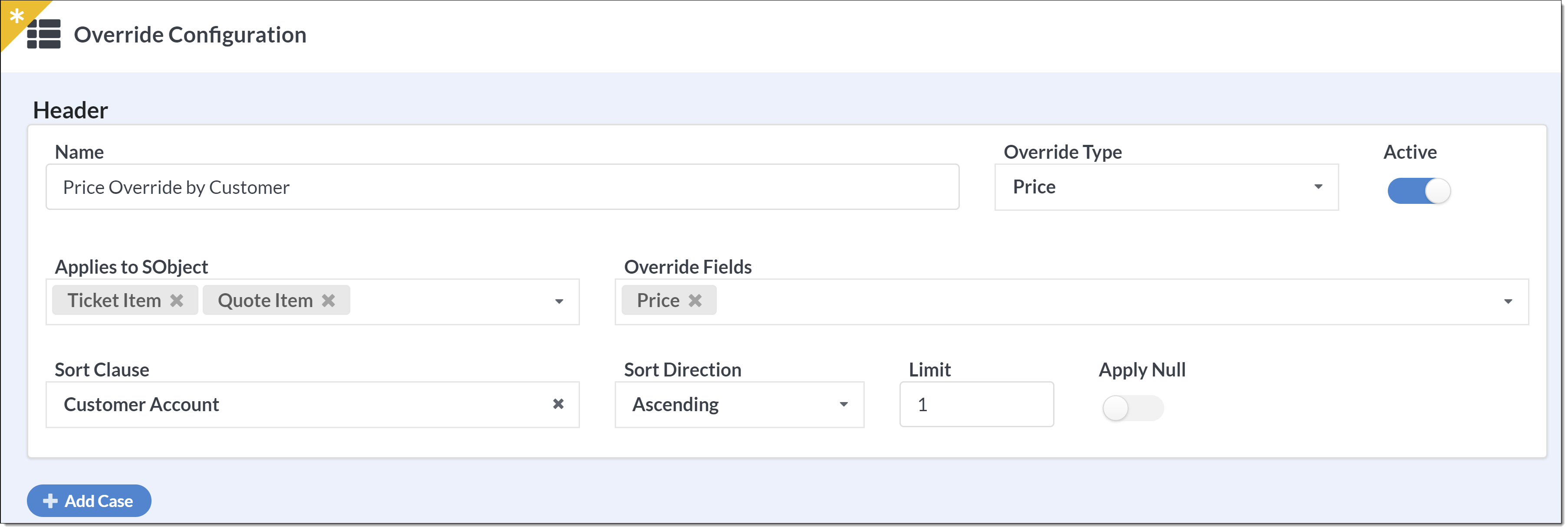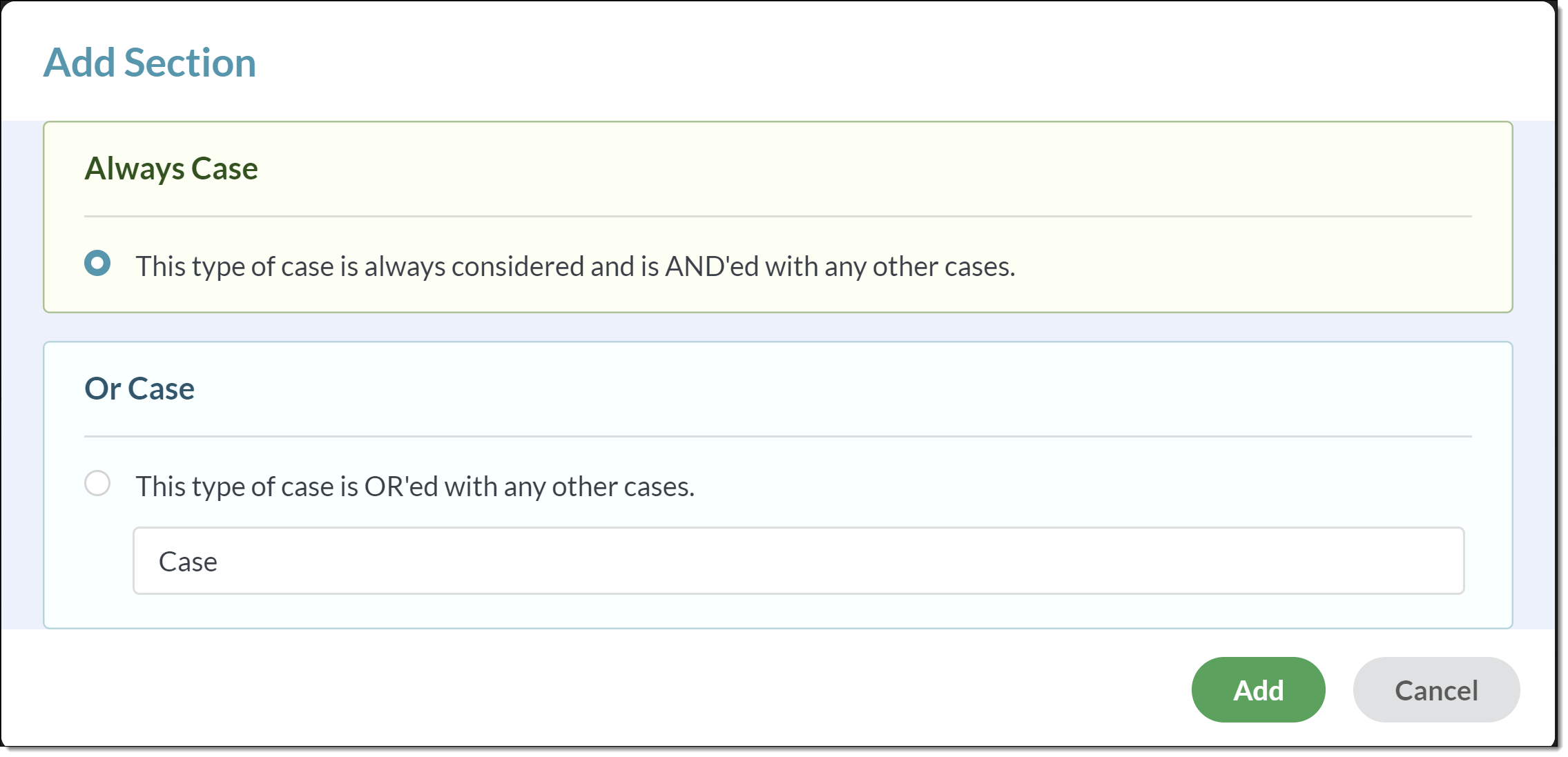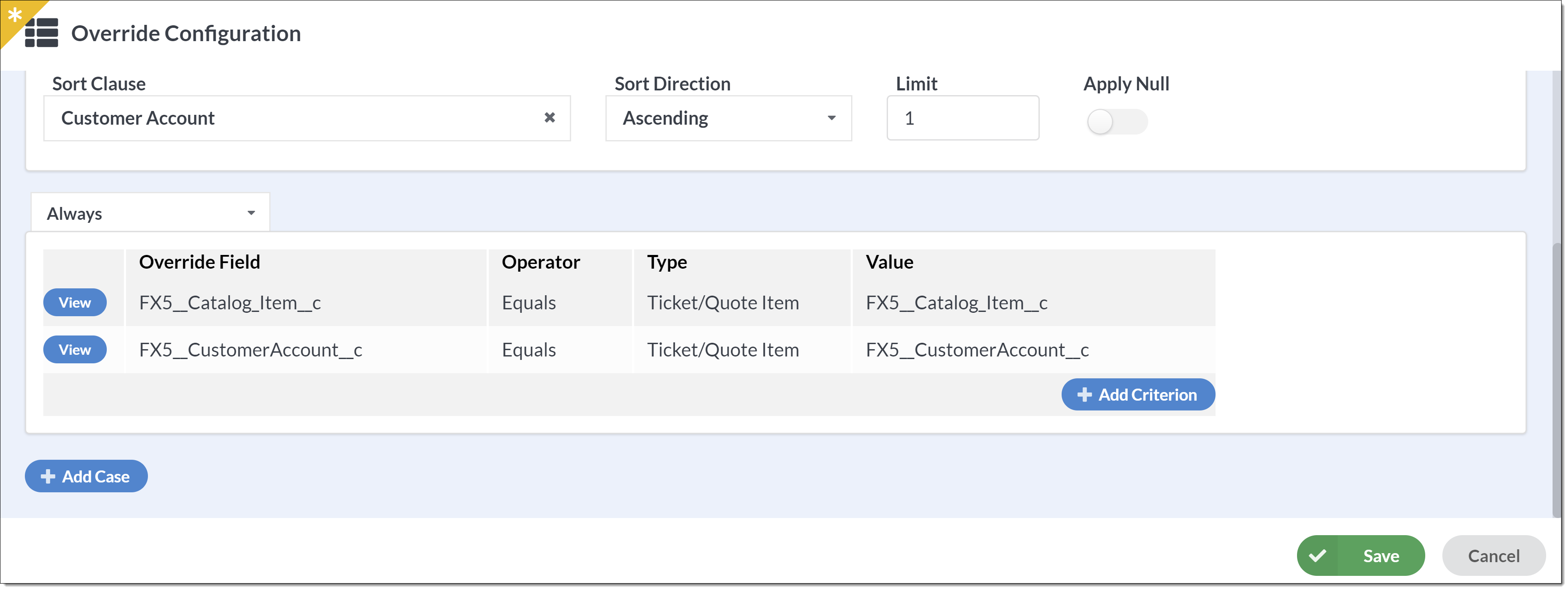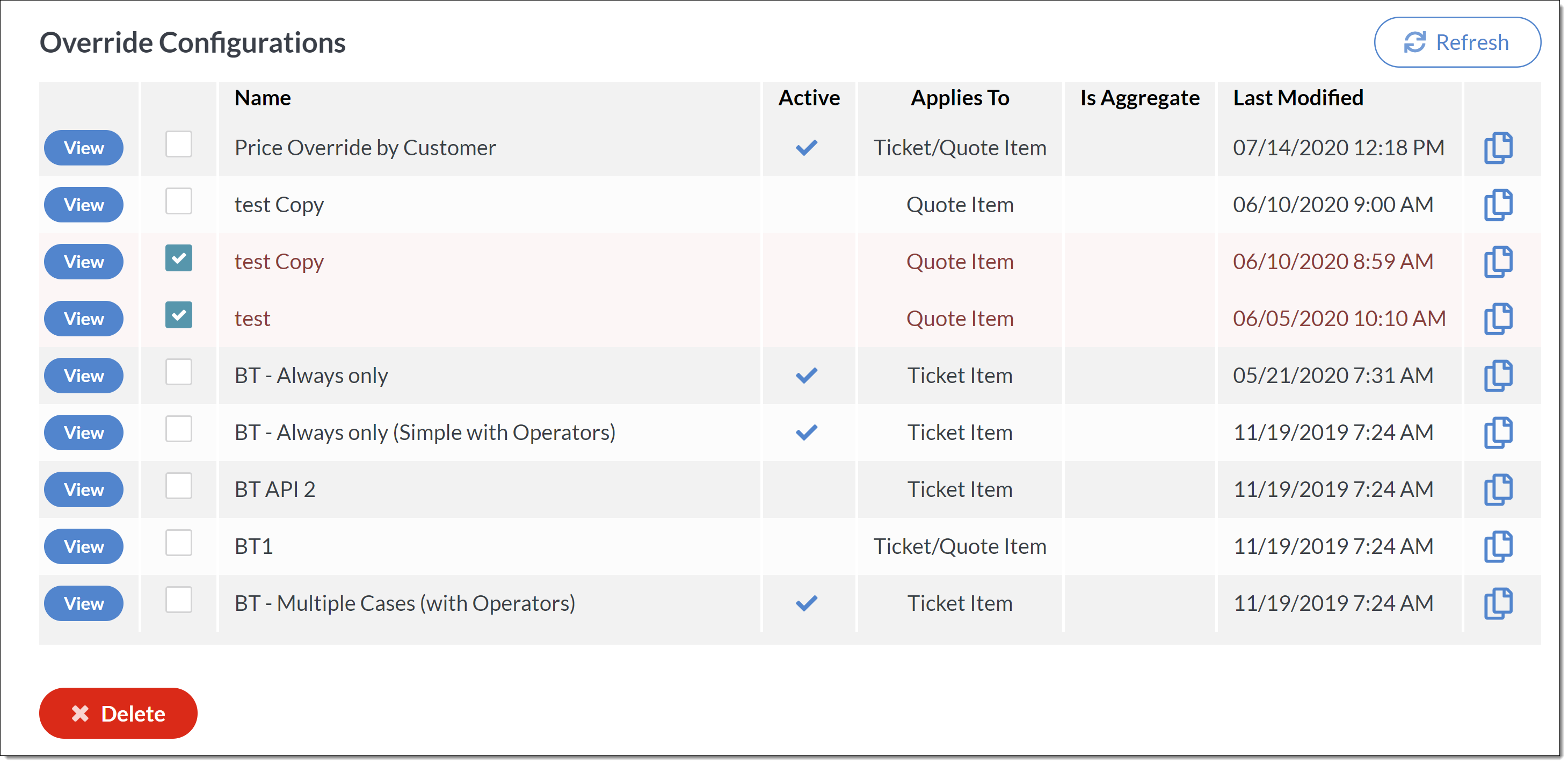Conditional Pricing
Prerequisites
-
Read the following article before you set up the Override Engine for the first time:
-
To set up the Override Engine, you need` the following licenses:
-
To set up the Override Engine, you must:
-
To set up the Override Engine, you need:
-
System permissions:
-
Customize Application
-
Manage Profiles and Permission Sets
-
View Setup and Configuration
-
Basics
The Conditional Pricing Tool creates the configuration records the FX CPQ Override Engine uses to update the price or cost of quote items, ticket items, and/or invoice items based on criteria.
When a price/cost override applies to an item, the item’s price/cost changes automatically and cannot be changed manually.
An Override Configuration set up in the Conditional Pricing Admin Portal Tool defines the rules that determine whether an Override should apply.
An Override defines the value to use when an Override Configuration applies.
|
Override values are defined in the Overrides tab in Back Office. |
Guidelines
Override Configurations
Records Updated by Overrides
The Applies to SObject field controls the records updated by overrides.
You can apply overrides to quote items, ticket items, and/or invoice items.
Override Configurations set up in the Conditional Pricing Admin Tool are assigned to Price Book Items in FX Back Office.
Prices and Costs to use when an override condition applies are defined in the Overrides Tab in FX Back Office
Fields Updated by Overrides
Enter the field(s) to update in Override Fields.
Select the Override Field(s) to which overrides apply.
| Only fields that can be used for the Conditional Pricing display. |
Override Cases
Add one or more Cases describe when an override condition should apply
Each case contains one or more Criterion
Add a Criterion to the Always Case if the condition must always be True for the override to apply.
| An Always Case is joined logically with an AND operator to other cases. |
Add an Or Case if the case may or may not apply. As long as one Or Case applies, the override is allowed.
| An Or Case is joined logically with an OR operator to other cases. |
Override criteria maps fields on the Override object to fields on the object to which overrides apply.
Handling Multiple Overrides
Sometimes there are multiple overrides applicable to an item.
To handle this, you must define sorting and limits to decide which override to use.
Complete the following fields to handle multiple overrides:
| Field | Description |
|---|---|
Sort Clause |
Enter the sort order of applicable overrides. Example 1. Sort by Catalog Item
Select Catalog Item to sort overrides in order by catalog item |
Sort Direction |
Whether to arrange matching criteria in Ascending or Descending order |
Limit |
Enter the number of overrides to consider. Example 2. Limit value examples
If you enter If you enter |
Price Overrides
Example: Adding Price Overrides Based on Customer
Scenario
In this example, we will add price overrides based on the customer.
Once we set up the overrides:
-
The prices of quote items will change based on the customer selected for quote items.
-
The prices of ticket items will change based on the customer selected for ticket items.
Setup Instructions
-
Log in to the Admin Portal at https://admin.fieldfx.com
-
Select the Conditional Pricing tool
-
Click the +Add button
-
Make the following entries:
-
Name:
Price Override by Customer -
Override Type: select Price
-
Active: Click the toggle to turn it blue and activate the configuration
You can wait to do this until the configuration is ready to launch.
-
Applies to SObject: select Ticket Item and Quote Item
-
Override Fields: select Price then click out of the field
This entry maps the Price field on overrides to the Price field on quote items and ticket items.
-
Sort Clause: select Customer Account
-
Sort Direction: select Ascending
-
Limit:
1Screenshot of the Override Configuration header section with entries for this example
-
-
Click Continue
-
Click +Add Case
-
Select the radio button for Always Case, then click Add
We will add two different Criteria that both must be
True, so they must be Always Cases for the override to apply.Always Case selected
-
Click + Add Criterion
-
Make the following entries:
-
Override Field: Customer Account
-
Operation: Equals
-
Type: Ticket/Quote Item
-
sObject Field: Customer Account
These entries say that the Customer Account on the Override must match the Customer Account on the Ticket or Quote for the override to apply.
-
-
Click + Add, then click +Add Criterion
-
Make the following entries:
-
Override Field: Catalog Item
-
Operation: Equals
-
Type: Ticket/Quote Item
-
sObject Field: Catalog Item
These entries say that the Catalog Item on the Override must match the Catalog Item on the Ticket or Quote for the override to apply.
-
-
Click +Add, then click Save
Two cases added as Always required
|
Complete the setup in FX Back Office by creating an Override for each customer as needed and adding the Override Configuration to Price Book Items as needed. |
Example: Adding Price Overrides Based on Quantity
Scenario
In this example, we will add price overrides based on a quantity. More specifically, the price override will be based on well depth.
Once we set up the overrides:
-
The prices of quote items will change based on the well depth selected for quote items.
-
The prices of ticket items will change based on the well depth selected for ticket items.
Setup Instructions
-
If not already created in your Org, create the following custom fields:
-
WellDepth__cfield onTicket__c -
TicketWellDepth__cfield onTicket_Item__cas the following formula:FX5__Ticket__r.WellDepth__c
-
MinDepth__candMaxDepth__conOverrider__cIf not already included, ensure the following fields are included on the specified page layouts:
-
IsAggregation, Sort Clause, and Limit on the Override Configs page` layout
-
MinDepth, MaxDepth, and Price on the Overrides page layout
-
Override Price Method on the Price Book Item page layout
-
-
Log in to the Admin Portal at https://admin.fieldfx.com
-
Select the Conditional Pricing tool
-
Click the +Add button
-
Make the following entries:
-
Name:
Price Override by Well Depth -
Override Type: select Price
This matches the Price field in the Override to the Price field on quote items and ticket items.
-
Active: Click the toggle to turn it blue and activate the configuration
You can wait to do this until the configuration is ready to launch.
-
Applies to SObject: select Ticket Item and Quote Item
-
Override Fields: select Price then click out of the field
This entry maps the Price field on overrides to the Price field on quote items and ticket items.
-
Sort Clause: select Well Depth
-
Sort Direction: select Ascending
-
Limit:
1
-
-
Click Continue
-
Click +Add Case
-
Select the radio button for Always Case, then click Add
We will add two different Criteria that both must be
True, so they must be Always Cases for the override to apply. -
Click + Add Criterion
-
Make the following entries:
-
Override Field: Customer Account
-
Operation: Equals
-
Type: Ticket/Quote Item
-
sObject Field: Customer Account
These entries say that the Customer Account on the Override must match the Customer Account on the Ticket or Quote for the override to apply.
-
-
Click + Add, then click +Add Criterion
-
Make the following entries:
-
Override Field: Catalog Item
-
Operation: Equals
-
Type: Ticket/Quote Item
-
sObject Field: Catalog Item
These entries say that the Catalog Item on the Override must match the Catalog Item on the Ticket or Quote for the override to apply.
-
-
Click +Add, then click Save
|
To complete the setup, add Overrides in FX Back Office and assign the Price Book by Well Depth Override Configuration to appropriate Price Book Items. |
Cost Overrides
Example: Adding Cost Overrides Based on Location
Scenario
In this example, we will add cost overrides based on the office.
`Once we set up the overrides:
-
The cost of quote items will change based on the office selected for quote items. *` The cost of ticket items will change based on the office selected for ticket items.
Setup Instructions
-
Log in to the Admin Portal at https://admin.fieldfx.com
-
Select the Conditional Pricing tool
-
Click the +Add button
-
Make the following entries:
-
Name:
Cost Override by Office -
Override Type: select Cost
This matches the Cost field in the Override to the Cost field on quote items and ticket items.
-
Active: Click the toggle to turn it blue and activate the configuration
You can wait to do this until the configuration is ready to launch.
-
Applies to SObject: select Ticket Item and Quote Item
-
Override Fields: select Cost then click out of the field
This entry maps the Cost field on overrides to the Cost field on quote items and ticket items.
-
Sort Clause: select Office
-
Sort Direction: select Ascending
-
Limit:
1
-
-
Click Continue
-
Click +Add Case
-
Select the radio button for Always Case, then click Add
We will add two different Criteria that both must be
True, so they must be Always Cases for the override to apply. -
Click + Add Criterion
-
Make the following entries:
-
Override Field: Office
-
Operation: Equals
-
Type: Ticket/Quote Item
-
sObject Field: Office
These entries say that the Office on the Override must match the Office on the Ticket or Quote for the override to apply.
-
-
Click + Add, then click +Add Criterion
-
Make the following entries:
-
Override Field: Catalog Item
-
Operation: Equals
-
Type: Ticket/Quote Item
-
sObject Field: Catalog Item
These entries say that the Catalog Item on the Override must match the Catalog Item on the Ticket or Quote for the override to apply.
-
-
Click +Add, then click Save
|
To complete the setup, add Overrides in FX Back Office and assign the Cost Override by Office Override Configuration to appropriate Price Book Items. |
Copy Conditional Pricing Configuration
Select the Copy icon to the right of a Conditional Pricing configuration on the list screen to copy the configuration.
The configuration Header and Cases are copied to a new configuration.
Adjust the Name and any other field, case, or criteria as needed, then click Save.
|
This makes it easy to create additional configurations for similar situations, such as when both the Cost and Price fields should change under the same conditions. |
Removing Conditional Pricing Configurations
Mark a Conditional Pricing as Inactive in the setups by clicking the Active toggle to turn it off.
| This retains the configuration so that it can be reactivated at a later time. |
Select the unlabeled checkbox of a configuration on the Conditional Pricing list screen to enable a Delete button.
|
You can select multiple configurations at the same time. |
Click the Delete button to delete the configuration.
|
This cannot be undone. |

Refresh Conditional Pricing Tool
Sometimes changes in FieldFX Back Office affect information available in the Conditional Pricing Admin Tool.
-
Changes to the list of Overridge Configuration setups on the Conditional Pricing tool’s home page
-
After adding a field, make the new field available in the Conditional Pricing tool
Select the Refresh button to
-
update the list of Conditional Pricing configurations
-
add newly added fields to those available for rule configuration